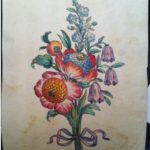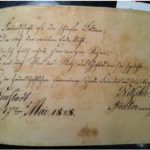Out of the Archives
When Facebook Was an Actual Book
by Alyssa Carver, Project Archivist, Center for Jewish History
This pretty bouquet comes from a circa 1828 Poesiealbum in the Pinkus-Peters Family Collection (AR 25520) held by the LBI Archives. Once belonging to Ernestine Fränkel of Neustadt (now Prudnik, Poland), the small, handmade volume contains personal greetings, drawings, embroidery, paper-cut art, handwritten poems and other mementos. The German word Poesiealbum literally means “poetry album,” but in English we would probably call it a friendship book, album amicorum, autograph album, or scrapbook—formats that, in any case, are rapidly being replaced by digital and web-based media. Interestingly, the paper-based friendship book remains relevant in German-speaking countries, which is where the tradition seems to have originated sometime in the 16th century. See a contemporary twist on this old idea in the music video for German hip-hop artist Samy Deluxe’s song “Poesiealbum” (and a link to translated lyrics here, via the Goethe-Institut).
One of the biggest issues facing the archival profession right now is the question of how to deal with the digital scrapbooks, online photo streams and ephemeral media being created in vast quantities every day. Ernestine’s friendship album is 185 years old—maybe a little faded, but in remarkably good condition. It is unlikely that electronic media today will be compatible with tomorrow’s software or as-yet-unimagined devices. So how do we preserve it for future generations? The Library of Congress is currently working on establishing standards for digital stewardship and offers some advice for personal archiving here. Local nonprofit organization Rhizome is dedicated to the study of “computer age” media and digital preservation, and is notable for pioneering community-sourced projects like the current XFR STN exhibit at the New Museum of Contemporary Art and the upcoming panel discussion on Born Digital Conservation.
Returning to 1828 for a moment, the Poesiealbum presents technical difficulties of its own, although the software involved in this case is the archivist’s. On the page opposite this ornate floral illustration is a personal dedication from the artist, stained slightly by the aging pigment of the bouquet. (See image above.) What makes the text difficult to read, though, is that it’s written in an antiquated German script.
Transcribed, this reads:
Die Freundschaft ist die schönste Blume
Die auf der weiten Erde blüht
Und die sich frisch erhält, zum ew’gen Ruhme,
So viel auch Neid und Stolz des Giftes um sie sprüht.Zur freundschaftlichen Erinnerung Ihres Freundes und Musiklehrers.
Many Americans today (including educators and archivists) have expressed concerns that students who are no longer learning cursive in school will soon be incapable of reading historical documents, let alone birthday cards from Grandma.
But perhaps that’s what we archivists are here for?


